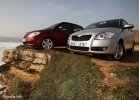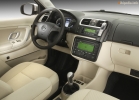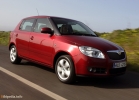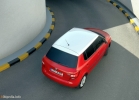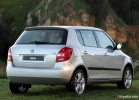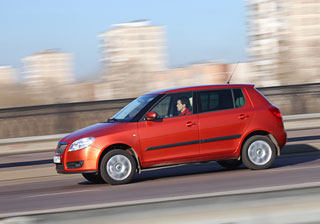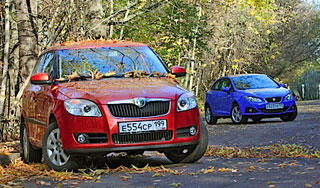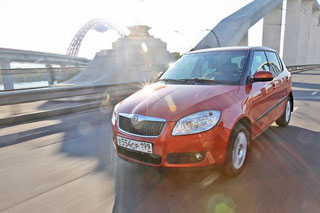Skoda Fabia test drive since 2007 -
Skoda Fabia Combi
 Modern station wagons look more sports than their predecessors and are not inferior to the hatchbacks and sedans in handling. Skoda Fabia Combi is a typical example of such evolution.
Modern station wagons look more sports than their predecessors and are not inferior to the hatchbacks and sedans in handling. Skoda Fabia Combi is a typical example of such evolution. Skoda Fabia Combi car for the brand special. The success of the new generation of Fabia will depend on how warm the market the market will meet this modification (it debuted in the spring of 2007). Of the 1.6 million copies of the first generation of Fabia (sales began in 1998) 640 thousand were on cars with a universal body. By the way, Fabia Combi is a special car not only for the Czech manufacturer, but also for the segment as a whole. Among the urban small -leafers in a model with a universal body, a rare phenomenon, and in the Russian market, is unique except for Skoda, no one else offers such modifications in this class today. Mainly Class B cars are hatchbacks or compactwane, much less often sedan.
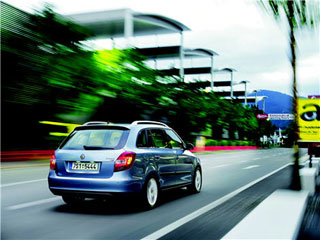 The Fabia Combi test was held in the Croatian city of Split. Against the background of the picturesque bays of the middle Dalmatia, the car looked quite harmonious. In fact, it is elegant to present in the back of the station wagon a car of such compact sizes is extremely difficult. In order to ensure acceptable scope in the cabin, the machine has to be made quite high, and the external dimensions installed for cars of this class do not allow to stretch the body. There is no need to talk about the lightness and swiftness of the appearance of Fabia Combi, but the station wagon from Skoda does not look with a colossus on clay legs. The upper window of the windows falls closer to the back, the car eliminates the car from the damn bar. Due to the long rear, the entire body is visually stretched, which provides harmony of proportions and gives the machine dynamism. Thanks to the designer tricks, Fabia Combi visually sticks to the roadway.
The Fabia Combi test was held in the Croatian city of Split. Against the background of the picturesque bays of the middle Dalmatia, the car looked quite harmonious. In fact, it is elegant to present in the back of the station wagon a car of such compact sizes is extremely difficult. In order to ensure acceptable scope in the cabin, the machine has to be made quite high, and the external dimensions installed for cars of this class do not allow to stretch the body. There is no need to talk about the lightness and swiftness of the appearance of Fabia Combi, but the station wagon from Skoda does not look with a colossus on clay legs. The upper window of the windows falls closer to the back, the car eliminates the car from the damn bar. Due to the long rear, the entire body is visually stretched, which provides harmony of proportions and gives the machine dynamism. Thanks to the designer tricks, Fabia Combi visually sticks to the roadway. 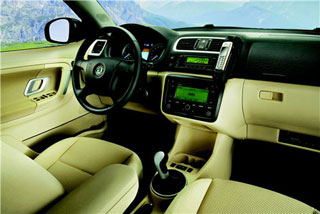 As for the interior, Fabia Combi is no different from the hatchback: in my opinion, Fabia is in no way inferior to German or Japanese competitors in the quality of materials and assembly.
As for the interior, Fabia Combi is no different from the hatchback: in my opinion, Fabia is in no way inferior to German or Japanese competitors in the quality of materials and assembly. Compared to the previous model, the area occupied by the car on the road has practically not increased (it has become the longer only 7 mm), nevertheless, the salon of the new station wagon is noticeably more spacious. This effect was achieved due to the vertical planting of the driver and passengers of the roof of the new Fabia Combi higher than that of the previous model, by 46 mm. The changes affected the arrangement and the cargo -passenger compartment. Thanks to the large interior, the car is capable of much its carrying capacity of 515 kg, regardless of the type of engine. With the back of the rear seat, the luggage compartment volume increased compared to the previous model of 235 liters to impressive 1460 liters, with the back of the rear seat, it increased by
 54 liters and amounts to 480 liters. Thus, the new Fabia Combi surpasses even many station wagons positioned by the class above. In addition, the model has the maximum in its segment the length of the cargo compartment.
54 liters and amounts to 480 liters. Thus, the new Fabia Combi surpasses even many station wagons positioned by the class above. In addition, the model has the maximum in its segment the length of the cargo compartment. The cargo compartment configuration can be changed using individual additional equipment: the cargo attachment system reliably holds valuable objects and protects them from damage. Gryaz and water-repellent rugs provide cleanliness during transportation. Thanks to compartments that are easily installed in different positions, the order is constantly maintained in the cargo space. The compact design of the rear axle made it possible to perform the luggage compartment with a low and even bottom, the corners and edges of the trunk do not interfere when loading. In addition, a small loading height (637 mm) facilitates loading and unloading.
 The platform and suspension of the COMBI model are the same as that of the hatchback, but the universal body is somewhat tougher for twisting and therefore some nuances of its handling are even more interesting: the car quickly and clearly reacts to the turns of the steering wheel, there is no hint of incompetence and satellite in its behavior. The COMBI suspension is configured to pronounced insufficient rotation, but the demolition threshold is pushed far enough so that the car drags out the turn, it is necessary to very much exceed the speed at the entrance to the turn. Such settings are optimal for safe driving: Combi goes to where the steering wheel is turned just what you need for a family car. The electro -hydraulic steering enhancer is helping to feel good, which provides clear feedback. Besides,
The platform and suspension of the COMBI model are the same as that of the hatchback, but the universal body is somewhat tougher for twisting and therefore some nuances of its handling are even more interesting: the car quickly and clearly reacts to the turns of the steering wheel, there is no hint of incompetence and satellite in its behavior. The COMBI suspension is configured to pronounced insufficient rotation, but the demolition threshold is pushed far enough so that the car drags out the turn, it is necessary to very much exceed the speed at the entrance to the turn. Such settings are optimal for safe driving: Combi goes to where the steering wheel is turned just what you need for a family car. The electro -hydraulic steering enhancer is helping to feel good, which provides clear feedback. Besides, 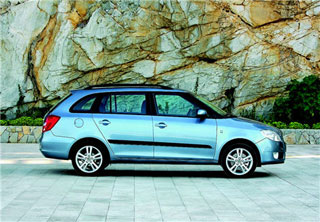 the electro -hydraulic principle of operation of the steering wheel amplifier reduces the fuel consumption, since its pump is turned on only if the increase is currently necessary (for example, when moving in a straight line it does not work).
the electro -hydraulic principle of operation of the steering wheel amplifier reduces the fuel consumption, since its pump is turned on only if the increase is currently necessary (for example, when moving in a straight line it does not work). The journey along the winding roads of the Croatian coast was a pleasure that did not smell even the far from the sporty character of the motor. For the test we got a car with a new aluminum gasoline engine with a volume of 1.6 liters and a capacity of 105 hp. (torque 153 Nm). Up to 100 km/h Fabia Combi with this engine accelerates in 10.4 s, and its maximum speed reaches 192 km/h. The indicators are not bad, but in attempts to light on the station wagon, promoting the engine above 4000,4500 rpm, there is little meaning to
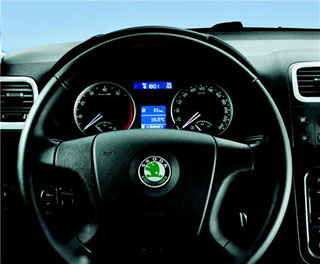 the engine begins to sour high speed. But even torque characteristics allow you to quickly start and not too often switch transmissions in calm traffic modes.
the engine begins to sour high speed. But even torque characteristics allow you to quickly start and not too often switch transmissions in calm traffic modes. For Fabia Combi, the same engines are offered as for the hatchback: three gasoline and three diesel power from 70 to 105 hp. None of the engines are tied to a certain version of the equipment. As in the Fabia model with a body of hatchback, the equipment of the highest level can be combined with the base engine, and the basic equipment with the most powerful engine. The standard for gasoline engines is 95th gasoline, but, as the manufacturer promises, they can work without problems on fuel with an octane number 91. In this case, the power is slightly reduced.
 The presentation of Fabia Combi surprised. And the point is not even in the car itself: it turned out to be absolutely balanced, harmonious, justifying expectations, this is exactly what is commonly called the Golden middle. They surprise, as a rule, extremes. Amazed the scale of the presentation of this completely utilitarian car. It took place in the most expensive and luxurious hotel of the coast of the Middle Dalmatia, converted for these days to the Skoda house. Recently, the delegations of Russian automobile journalists are one of the most numerous in test drives (the special interest of automakers in the fast-growing market is affected), but in SPLIT we were just crushed by the number of colleagues from Germany: 130 (!) Took part in the Fabia Combi test drive (!) German journalists. In previous years, Skoda represented new products in a more modest setting.
The presentation of Fabia Combi surprised. And the point is not even in the car itself: it turned out to be absolutely balanced, harmonious, justifying expectations, this is exactly what is commonly called the Golden middle. They surprise, as a rule, extremes. Amazed the scale of the presentation of this completely utilitarian car. It took place in the most expensive and luxurious hotel of the coast of the Middle Dalmatia, converted for these days to the Skoda house. Recently, the delegations of Russian automobile journalists are one of the most numerous in test drives (the special interest of automakers in the fast-growing market is affected), but in SPLIT we were just crushed by the number of colleagues from Germany: 130 (!) Took part in the Fabia Combi test drive (!) German journalists. In previous years, Skoda represented new products in a more modest setting. Well, the company has every reason to increase the budget to promote its models. The Czech car producer constantly increases production and expands the lineup. According to the results of 2007, the number of Skoda cars sold increased by 15%. New production opened in Russia and China. Investments in promising developments increased by 30%. Skoda’s affairs are going well, which was confirmed by the test drive of the new Fabia Combi.
Some technical characteristics of Skoda Fabia Combi
Dimensions, mm 4239x1642x1498
Equipped mass, kg 1090
Base, mm 2462
Front/back, mm 1436/1426
Engine type gasoline 4-cylinder 16-valve
Working volume, cubic meter. cm 1598
Max. Power, L.S./rpm 153/5600
Max. moment, nm/rpm 153/3800
Mechanical transmission 5-speed
Front drive
Max. Speed, km/h 192
Acceleration time 0-100 km, from 10.4
Fuel consumption (average), l/100 km 6.9
Igor Komarov
Photo of the manufacturer
Source: Avtopanorama magazine
Video Skoda Fabia test drive since 2007
Video crash tests Skoda Fabia since 2007
Skoda Fabia test drive since 2007
Skoda Fabia crash test since 2007
Krassh Test: Detailed Information32%
Driver and passengers
17%
Pedestrians
36%
Children-passengers
Skoda Fabia faults since 2007
Skoda Fabia malfunctions: Detailed information| Fabia since 2007 | |
|---|---|
| Engine |  |
| Transmission |  |
| Control system and suspension |  |
| Brake system |  |
| Air heating and air conditioning |  |
| Launch and charging system |  |
| Electric components and so on |  |
| Corrosion body stability |  |

